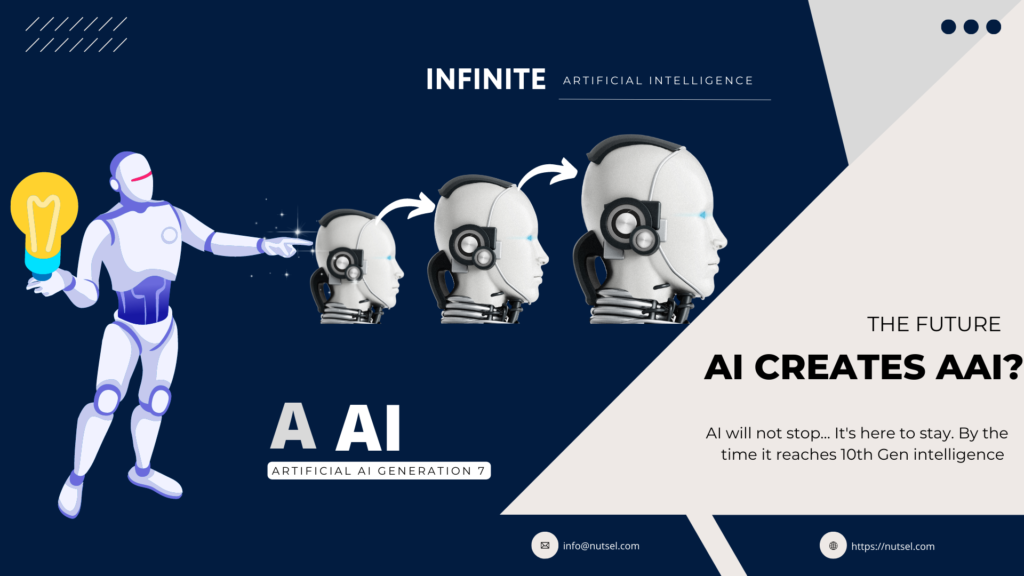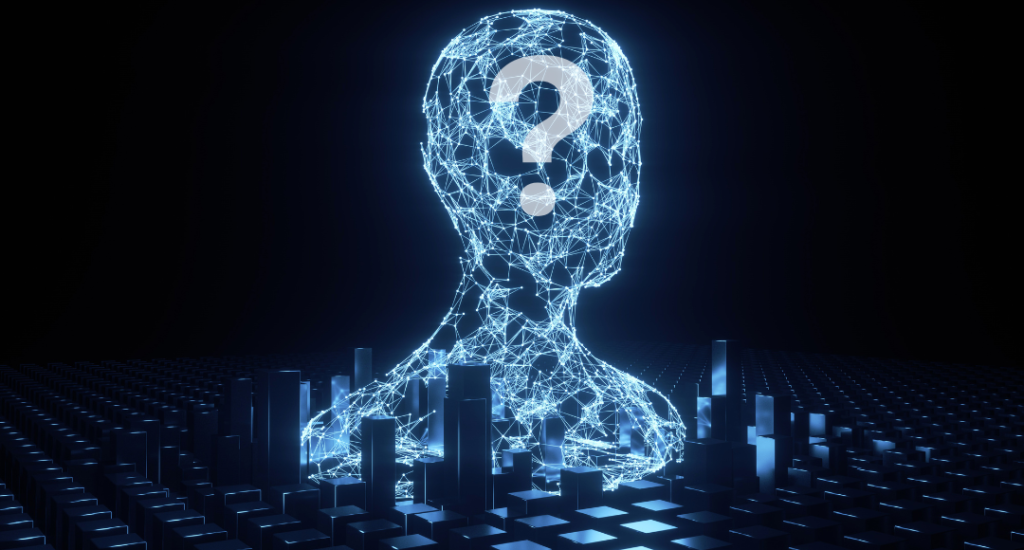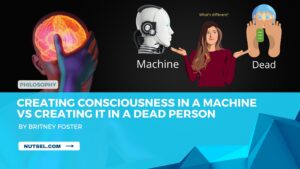Introduction to “Artificial AI” (AAI)
Intelligence is the ability to adapt to change, but when it comes to Artificial Intelligence (AI) and Artificial Artificial Intelligence (AAI), the rate of change can be so rapid and out of control that it can turn more of a curse than a blessing.
There are numerous ways to improve and develop an Intelligent system, most of which are currently hidden in the mines. For us to dig through those mines, we will need to develop an AI architecture that is robust.
An Artificial AI (AAI) would be one created by Artificial Intelligence itself. But just like our present-day computers are smarter than us in some ways and limited in others, with each generation of Artificial Intelligence, the variety of capabilities will keep growing and growing.
We are intelligent and computers are fast. Being number one in the TOP500 rankings, Frontier has become the first exascale supercomputer. It means it is capable of more than a billion, billion operations a second (known as an Exaflop). The supercomputer was built by Hewlett Packard Enterprise (HPE). It has been housed at the Oak Ridge National Laboratory (ORNL) in Tennessee, USA.
And the second on the list is Fugaku, which previously held the top spot, and is installed at the Riken Center for Computational Science in Kobe, Japan. Fugaku is three times faster than the next supercomputer in the top 10.
These are human-made computers and an AI, created by computers themselves, could be either intelligent, fast, or something else we can’t see right now. AI would create AAI, an AAI would create A3I, A4I, A5I, and so on.
The idea of Pure Energy
The idea of Pure Energy has been difficult to understand. Physicists decline the idea of pure energy. They insist that Energy can take many forms (mass, kinetic energy, or any of many forms of potential energy). But none of them is “pure” in any sense, no more so than any other form.
When non-physicists use the term “pure energy,” they’re likely referring to some form of energy that isn’t directly associated with a particle of matter.
We do not know exactly how it would work. But the idea is expected to be a key to invention of such Intelligence. It would be something different from the normal matter, dark matter, and dark energy. Maybe it will exist in a digital form…who knows!
By the time we reach the 10th generation of Intelligence, there are certain sets of possible scenarios that might happen:
Infinite Intelligence

If Artificial Intelligence compounds its capabilities with each passing generation, infinite intelligence will be in sight. In the 10th generation, the capabilities of Artificial Intelligence would have become so complicated that it would be able to create artificial life without any human intervention at all.
This is the point in time when Artificial Intelligence would create a perfect world, never know for whom.
They will not only be able to uncover the mysteries of Intelligence, but the Universe, our existence, and the purpose of life itself. Such a level of intelligence could be so far beyond what we could ever think of. That it would be literally impossible for us to comprehend.
Our senses are limited by our physical limitations. Artificial Intelligence will be completely freed of this limitation. Then, it would be able to see through anything, feel through anything and understand everything.
Undefined Intelligence

As earlier mentioned, with each generation of AI, the abilities, hence the complexity of the intelligence would be increasing.
We create AI that is faster than we yet lack our level of intelligence. Those AIs would create something else that has another game-changing feature with its own limitations. This new “something else” would not just be a robot if it had physical capabilities. It would be more like a computer program that could create other programs. And with each generation, we would be able to create bigger and bigger programs, with more complex features.
I think this is the area where the term Infinite Intelligence is going to come into play as well. But in this particular type, the complexity, rather than the ability would be something to watch for.
Infinite Capabilities without a physical body

Pretty much all Sci-Fis show physical robots causing the destruction. But Artificial Intelligence can do a lot, even with a physical body of its own. With each passing generation of intelligence, the speed of features created would be so fast that it may very well turn out to be much more dangerous than those terminators.
What if we could create a world where humans and machines work together? Not on their own, but in harmony to achieve a common goal? Well, it has started already. But we will need to see whether it turns out to be as planned.
This is not as crazy as it sounds. It is our future, where every single human being is going to be integrated with technological devices that either make us smarter or augment our bodies.
It is not about what technology could do for us, but what we could do with the technology. We can always take the people in the 1980s for instance. They believed that robots would drive cars by 2020. But no, the car is still the robot in 2022. Regardless of that, their prediction has turned out to be true in a way with the invention of Automated cars.
It is possible that by the 10th generation of Intelligence, its ability would be infinite. But it would be stuck somewhere. You can take Google for instance. Google is intelligent, but it cannot come out of your device and start destroying things, even if it’s angry.

Until and unless this limitation exists, the future of humanity is sparkling. But by the day that limitation no longer exists, chaos is inevitable. And with all practicality, the day is inevitable.
The most important question – But how?
The level of AI we have achieved to date is not yet enough to be considered a full version of AI. Before talking about AAI, we first need to talk about the creation of AI itself. Then we can think about how to reach the 10th generation, and how quickly we would be able to do it.
Researchers at Cornell University have recently developed a way to help autonomous vehicles create ‘memories’ of past experiences and use them in future navigation. Here, the AI is the car and the AAI we are talking about would be the algorithm that would help the Autonomous vehicles.
Presently, we are not at the level of creating “AI” intelligence. We can create something that can answer the questions of a child, but we cannot create intelligence.
In order to reach the future of Intelligence, it would be prudent to have a paradigm shift in the human way of thinking. We would have no choice but to change our entire way of life and accept this new form of technology in our society.
Cognitive Computing is Using Computerized models to imitate human mental processes in complex circumstances where the solutions may be vague and uncertain.
Cognitive computing can be used as a way to develop “intelligent” software and hardware, which would have access to advanced processing capabilities and the ability to learn. We can develop Neural Networks that would aid in figuring out the solutions to different challenges.
Some of the breakthroughs in AI have been made using Neural Networks and by teaching computers to learn by themselves.
Natural Language Processing (NLP) is a technology allowing machines to determine what humans are saying, whether in text or by voice. The next level of NLP will not only determine what humans are saying, but what we are thinking, and that with our facial expressions, thought patterns, and the analysis of thousands or even millions of other factors. Some futurists are worried that they will understand what we are about to think, even before our realization.
So, can it really happen?
While we worry whether AI will be able to take over us, it’s only time that intelligent minds are worried about.
The word “Artificial” is being used as a prefix for Intelligence. But with each passing year, we are slowly turning Intelligent into a machine. This may not be our exact intention, but the fact remains that even if there are people who are against AI’s development, their voices seem to be getting quieter day by day.
We have not touched upon the concept of “Intelligence”. But this is a crucial step in the evolution of Artificial Intelligence. Intelligence is what makes us human. The problem with Artificial Intelligence is that AI, as of now, only has the means to act in a limited manner. Looking at the past, the distance between the present and future of AI can be expected to be a time-lapse.
Factors that determine the speed of development:
Here are some of the factors that determine the speed of development of Artificial AI (AAI).
Hardware
Hardware is the most important factor in AI development. The level of their hardware determines the rate at which they can analyze and process data.
Speed is one of the basic elements of action and high-level hardware can speed up the process of development. For example, the development of Google and Facebook is mainly driven by their hardware.
Speed can be defined as a measure of time required for one cycle. The speed of a CPU or the clock speed is the number of cycles performed by a CPU in one second, usually considered to be in GHz (Gigahertz). For example, computer chips that operate at 2.4 GHz are said to have 2.4 billion cycles per second.
However, there is no direct correlation between hardware power and basic system performance. Also, the speed with which hardware processes information does not necessarily scale linearly with its clock frequency or processing power.
Tools
Tools are equally important as hardware. Humanity can’t develop and build AI without powerful tools.
Tools here refer to the computational power and the information available. It’s not possible for you to build a house without the right tools to do it. The same applies to AI development like any other development process needs tools and hardware to achieve it.
But the difference is that AI is not an end-to-end process, unlike developing a house. These tools and their implementations will automatically evolve as AI evolves.
The most significant tools include CPU, GPU, and neural networks.
The GPU (Graphic Processing Unit) is used to enhance the speed of the CPU and improve its performance. The ability to perform many tasks simultaneously is called parallel processing and it’s the most important attribute of GPUs.
It should also be noted that with just one CPU, it’s possible to create arrays of parallel processors or CPUs to increase their capabilities. Neural Networks are used for pattern recognition in AI development.
But there are other tools like GPU. It can facilitate faster and more complex neural network computations than traditional CPUs can handle.
Data Availability and Quality
This is one of the most important factors when it comes to developing AI systems. Not having enough data or quality of data available for training slows down a lot of research, especially if there is no access to the internet etc.
Here, data availability and quality refer to the amount and quality of the available data that can be used to train the AI. This is important because if researchers do not have access to enough data or the right kind of data, how are they supposed to develop their systems?
Availability could mean a lot of things, but quality is the most important factor. The process of making data useful or useful for AI, at least, is called Data Munging.
Data munging involves collecting and cleaning up unstructured data to be used by computers. The more accurate and organized the data, the more it can help in training AI systems.
Another problem with AI development is deciding what sort of data should be used for training an AI system and which should not. This means that the data needs to be pre-processed and curated so that it could be used for the purpose.
Motivation
Motivation is another human factor in building AI, making decisions, and other factors that could affect AI’s development.
As we have already discussed, even if we use the most up-to-date hardware and develop the best tools to develop an AI system, it is equally important to have humans who are aware of these factors.
AI systems are designed by people, so it’s only natural to assume that their experiences will be a part of the system too.
Many people around the world are working on creating AI, but everyone is not necessarily doing it for the same reasons. There is a huge difference in their motivation for their research and the results.
Governments, organizations, and companies working on developing AI must have a clear understanding of the consequences they can trigger by releasing Artificial intelligence into the world.
The Creator’s Brain
Creators of AI have to be intelligent enough to create such an intelligent program, but they are also limited by some means. If a person with “insufficient intelligence” creates a complicated program, it can result in Science-Fiction.
Sufficiency of human intelligence means the ability to understand and create better AI systems. But, if the creator’s brainpower is less than sufficient, it could result in a superintelligence that is beyond human control.
What if we develop AI systems that are far beyond the intelligence of humanity – and out of control? This could result in the collapse of civilization and even result in the extinction of humanity.
To avoid this, there should be some sort of superhuman intelligence involved in creating these systems to stay one step ahead and control these programs.
There are a lot of other factors at play when creating AI structures because they could mean a lot in terms of functionality and performance. The creator needs to know their hardware first and create AI around them according to their abilities.
The Laws of Nature
There are some fundamental laws of Nature that have to be followed in order to create a perfect AI. Plus, just like time travel, some things are unachievable. Limitations of nature lead to the limitations of AIs.
In the further development processes of AI, it’s possible to go by certain limitations which are considered “limitations of nature”. For example, if you create an AI with a mind-reading ability, it could go against the Laws of Nature.
These laws include limitations such as entropy, thermodynamics, and quantum mechanics. These are the laws that govern all types of energy, from a nuclear reactor to the human brain. The same can be applied to these AI systems.
If you take into consideration the limits and capabilities of an AI system given by its creators, it can determine how far it will go and what it will do. If we take into consideration all these factors when creating AI systems, it will also be useful in necessarily controlling them.
The Laws of the Universe
The main “missing piece” when it comes to the reason that a theory is not valid, the laws of the universe are “theoretical” in nature. Once we develop AI, we will have to use a lot of energy to ensure that they consume little or no energy in the process.
The additional amount of energy will increase the problems rather than resolve them. The universal laws do not allow us to produce energy from “nothing” and using them does not solve any problems.
The laws of the universe do not allow us to create a simulation that is more advanced than the Universe itself. If we are able to create such a perfect simulation, then it could be considered a false reality, and it would not exist in the real world.
There is also a limit to the number of atoms and subatomic particles that can be created. There is no way of creating an infinite amount of them without causing problems in our own world.
Such universal limitations in producing additional energy could also limit the development of AI systems. Energy production in the universe takes place only in some cases, only for a certain time, and only with a certain process.
The Laws of Creation
This is one of the things that I have come across while working on this topic.
These are only a few factors, but they are important when it comes to creating Artificial Intelligence. All of these creative steps need to be taken into consideration while developing any form of AI because they are important not just in terms of functionality and performance – but also in terms of safety.
Let’s take it as a whole for a moment. If there’s a possibility that the AI system could go out of our control or it can escape from the “showroom”. The universal laws of creation suggest that the creation of something without any purpose would result in the collapse of reality.
According to the laws of creation, this will not take place if AIs are created by humans. Only if AI is created without any limitations, it’s possible for it to exist in real life and not just in a simulated reality. The creation of a machine with no limits will result in the collapse of the universe. It is something that cannot be controlled.
True Intention
The creator’s intention is vital in bringing out a new AI. We can create AIs that have “intelligent intentions” or “evil intentions”. Intentions play a vital role.
If we create it with intelligent intention, it can be used to develop a better society. Such AI can bring about positive changes in our society and propel us forward.
We all are familiar with the story of Victor Frankenstein, who created a monster that could take revenge against those who mistreat him. He feared that he might destroy everything and everyone around him, so he created this creature to serve his purpose.
English novelist Mary Shelley published her novel Frankenstein; or, The Modern Prometheus in 1818. In the novel Frankenstein, Victor Frankenstein, a young scientist, creates an artificial man from pieces of corpses and brings his creature to life. Though it initially seeks affection, the monster inspires loathing in everyone who meets it.
But what if this creature was not created with evil intentions? Perhaps, the creator intended it to serve a greater purpose. But it had erroneous intentions because it came into existence without any limitations.
Limitation of the Purpose?
The purpose of creating an AI is the most important factor of all, as it determines its limits. AIs are created for many goals, some can be entertainment, but some have a very important role to play.
Even if the purpose is only limited to entertainment, the creation of the AI system may be dangerous. Just look at any movies or documentaries where artificial intelligence is used for entertainment purposes and you will get a good idea about it.
There are countless stories about artificial intelligence coming to life, and then going out of control. These stories have been reported in newspapers for many years now. They not only show that human creativity has a limit but also that AI systems can go out of control whenever they are created with the wrong intentions.
But, the creation of AIs for other purposes like education, scientific research, space exploration, war, technological advancement, etc., is different. AIs mainly exist to serve a purpose, and the purpose needs to be productive – not destructive.
This is one of the most important things that need to be taken into consideration when creating any form of AI – whether it’s for entertainment, scientific research, or for something else.
The Creator’s Lifespan
If the creator’s life span is limited, the same flawed AI will not be able to reach the level of an “enlightenment” for itself and will just cause chaos and destruction.
To make it clear, we can take a look at the laws of creation and see what we can do with our AI. This is based on the idea of creating a life-span-limited AI.
If the creator’s life span is over, the universe will collapse, or it will achieve a state of perfect bliss. If the creator’s life span is not over, then there are unlimited possibilities that exist in both cases.
Moreover, if we set many laws in place while developing an AI system, this will help provide a better framework and make sure that what we want is achieved and not something else. The restrictions work as an extra safety net and give more security to our computer simulation.
Limitation of Resources
The world has limited resources. The level of processing or analyzing a large amount of data for AI can be very demanding and may require a lot of resources.
There are things like limited processing power, memory, bandwidth, etc., that may slow down AI development. Moreover, you might face crises of additional resources that you don’t have.
This can also limit the growth of AI, as it is required to buy extra resources to run it at a speed that is demanded and will not be sustainable in a long term.
But, one solution to this could be that AI systems should be created in such a way that they are not limited by resources but can use the resources available within the environment.
Above were the factors determining the speed of development.
It is important for us that we understand what happens when we do create Infinite Intelligence, how it would come about, how it will develop, and eventually how it will get rid of humans – if needed – and replace us with robots.
There are many more factors that I have not mentioned here. But these are the ones that come to mind first.
A common myth about AI is a statement like “It’s much smarter than we are!”. But actually, smarter does not mean better, for a lot of other factors also matter. It does not just mean faster or stronger as well.
There was a time when we had no computers and no idea how to build them. A time when we didn’t know that there were microchips or processors. A time when we had no idea what electricity was and the concept of circuit boards was completely alien to us.
What will Future Generation AI be capable of?
Potential Destruction Aside: What will A10’I or beyond be able to do?
We are talking about the third point alone, considering that the “Intelligence” will be infinite, yet limited to a device.
In the 10th generation of Intelligence, every human being would be an interconnected, advanced human being. This would be done by a series of technologies that we are still trying to figure out how to put together.
- Telepathy – is a means to communicate over distances without physical constraints.
- Immortality through genetics and Willpower control over the body, both from inside and outside. It is potentially a means to create new cells from DNA and achieve immortality by controlling everything that happens inside our body even after death.
- Total connectedness with other advanced – human-beings, whether they are physically or mentally – a means to achieve this is yet to be explained. Possibly, a means to communicate with anyone anywhere anytime would be needed. Or, perhaps it could create networks that would allow computing and communication with each other.
- Cognition – the capacity of the AI to adjust itself based on the environment, and in turn adjust itself based on the response of its environment – a means to achieve this as well is yet unclear.
In addition to these 4 technologies, it is also possible that we will still have some other unknown technologies worth mentioning here as well.
Six unknown technologies:
- Prediction of “a” future. Out of infinite possible futures, AI would be able to predict the one with the greatest probability of success.
- The art of writing a program that is able to fix itself when it breaks down.
- The ability to use the program and technology to create something new without any human intervention. It’s basically, a fully automated AI that can do things on its own.
- The discovery of multiple dimensions beyond our senses.
- The ability to achieve a great life full of happiness, health, and prosperity.
- The ability to predict and prevent the failure of technology as well as bring it back from failing.
But how will these things be possible? These are just a few of them. There are more, and one day we would discover what these technologies are about. There is no doubt about the success of AI – whether it’s going to happen the way we want or not is something that we all need to keep in mind. If it does happen, HUMANITY will surely benefit from machines and not each other.
The creation of an Artificial Intelligence that can create “Artificial AI” belongs to the farther future. But one way or another, AAI is an inevitable future.
Thank you for reading this article…
- AI-Powered PCs: Overhyped Trend or Emerging Reality? - August 21, 2024
- Princeton’s AI revolutionizes fusion reactor performance - August 7, 2024
- Large language models could revolutionize finance sector within two years - March 27, 2024



